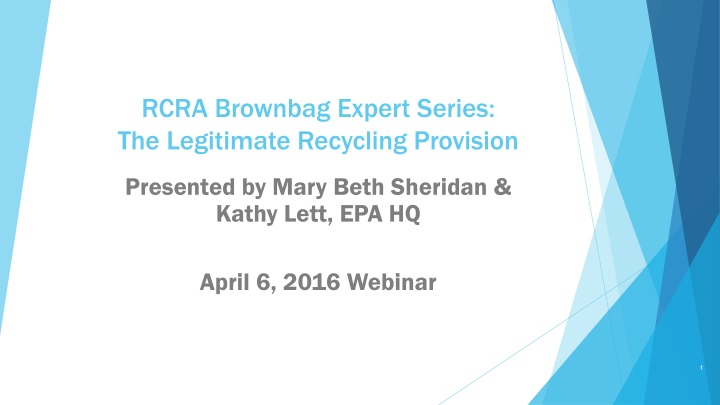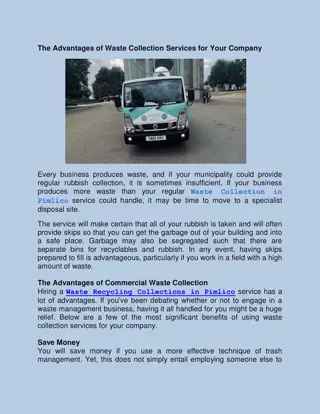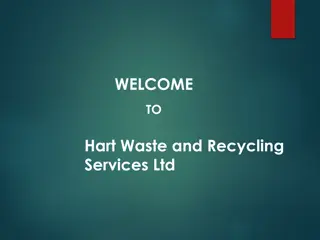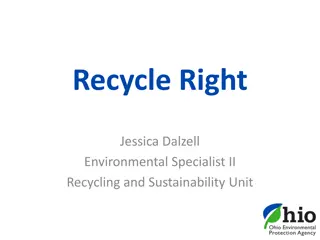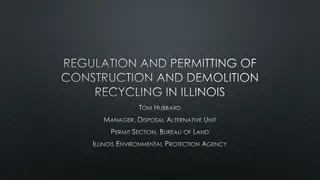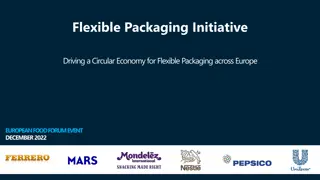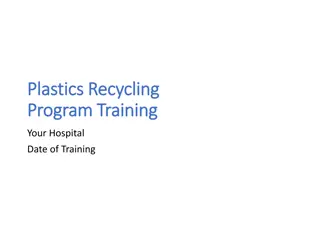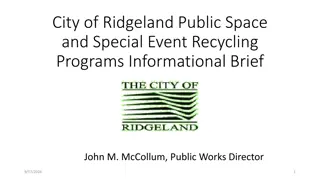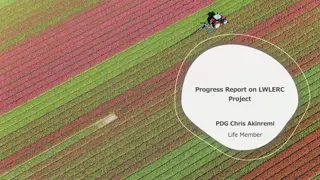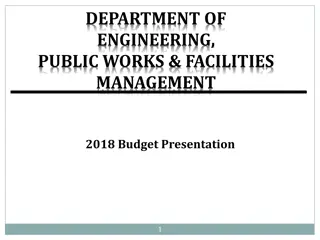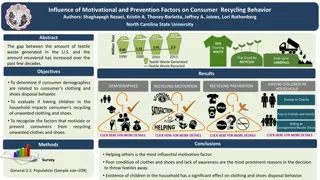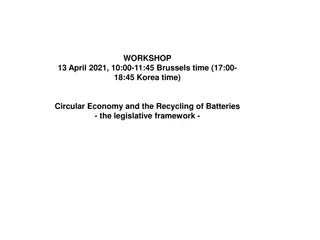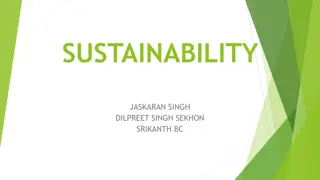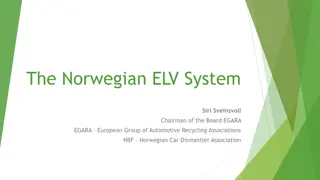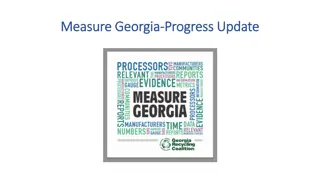Legitimate Recycling Provision Exploration
This content delves into the legitimate recycling provision under RCRA regulations, distinguishing between legitimate and sham recycling practices to ensure compliance and environmental responsibility. It covers key environmental issues, regulatory aspects, and factors impacting the determination of legitimate recycling.
Download Presentation

Please find below an Image/Link to download the presentation.
The content on the website is provided AS IS for your information and personal use only. It may not be sold, licensed, or shared on other websites without obtaining consent from the author.If you encounter any issues during the download, it is possible that the publisher has removed the file from their server.
You are allowed to download the files provided on this website for personal or commercial use, subject to the condition that they are used lawfully. All files are the property of their respective owners.
The content on the website is provided AS IS for your information and personal use only. It may not be sold, licensed, or shared on other websites without obtaining consent from the author.
E N D
Presentation Transcript
RCRA Brownbag Expert Series: The Legitimate Recycling Provision Presented by Mary Beth Sheridan & Kathy Lett, EPA HQ April 6, 2016 Webinar 1
What is the Purpose of this Webinar? This webinar is intended to provide a roadmap of the right questions to ask when dealing with the RCRA definition of legitimate recycling. This webinar is not a training; in general, you won t find specific answers to legitimacy determinations here. However, by the end of the webinar, you should know where to find those answers. 2
Key Environmental Issue: Sham recycling Sham recycling (recycling that is not legitimate) is disposal of hazardous waste in the guise of recycling. Determining whether hazardous waste recycling is legitimate or sham depends on case-specific circumstances. Sham: Lead-contaminated foundry sands reused as playground sand During 1997-1998, 375 tons of lead- contaminated foundry sand (with concentrations above the Toxicity Characteristic) were bagged and sold as play sand to 40 different retailers throughout Georgia, Virginia, North Carolina and South Carolina. Legitimate: Lead-contaminated foundry sands reused in foundry molds In 2001, EPA issued a memo clarifying that the reuse of foundry sands for mold making in a facility s sand loop following normal industry practices is legitimate reuse. 3
Legitimate recycling in the regulations The legitimate recycling provision is codified at 40 CFR 260.43 and applicable to all hazardous secondary material and hazardous waste recycling. It is a clarification and simplification of the long-standing policy for legitimate recycling (as far back as 1985 preamble and 1989 guidance). Prohibition on sham recycling is codified at 261.2(g). 4
How does legitimate recycling relate to the RCRA definition of solid waste? Last month, Tracy Atagi gave a brownbag on the RCRA Definition of Solid Waste (DSW) Sometimes hazardous secondary materials are solid waste when recycled, sometimes they are not. If not solid waste, they are not regulated under RCRA hazardous waste regulations. As a result, sometimes facilities try to get out of the RCRA regulations by claiming they are recycling a hazardous secondary materials when they are really just discarding of the materials in the guise of recycling. The definition of legitimate recycling gives codified guidance on how to distinguish real recycling from sham recycling. 5
Four legitimacy factors: Factor 1: Materials must provide a useful contribution to the recycling process or to a product or intermediate (40 CFR 260.43(a)(1)). Factor 2: Recycling must produce a valuable product or intermediate. (40 CFR 260.43(a)(2)) Factor 3: Materials must be managed as valuable commodities. (40 CFR 260.43(a)(3)). Factor 4: Products of recycling must be comparable to legitimate products or intermediates. (40 CFR 260.43(a)(4)). *Must meet all four to be legitimate recycling. 6
Factor 1: What does it mean to provide a useful contribution? A material provides a useful contribution to the recycling process or a product or intermediate if it: Contributes valuable ingredients; Replaces a catalyst or carrier in the recycling process; Is a source of a valuable constituent recovered; Is recovered or regenerated; OR Is used as an effective substitute for a commercial product. Reg citation for Factor 1: 40 CFR 260.43(a)(1). 7
Common Examples of Useful Contribution Spent Catalyst (Catalyst can be regenerated) Metal Bearing By-product or Sludge (source of recovered metals) Sulfuric Acid from Air Pollution Control System (Can substitute for virgin acid) Spent Solvent (Solvent can be recovered to be used again) 8
Factor 1: What does it mean to provide a useful contribution? The hazardous constituent does not have to be what is being recycled. For example: zinc recycled into micronutrient fertilizer from a hazardous secondary material can meet factor 1 even though zinc is not the hazardous constituent. BUT, the recycler is responsible for proper management of any hazardous residuals. If two or more hazardous secondary material are blended together prior to recycling, both must meet factor 1 and contribute to the final product or to the process. This is in order to prevent blending to try and meet the factor. 9
When Blending, Both Materials Must Provide a Useful Contribution. Material 1 Must Provide a Useful Contribution Combined Materials Must Provide a Useful Contribution Material 2 Must Provide a Useful Contribution 10
Factor 2: What does it mean to product a valuable product ? Recycling produces a valuable product or intermediate if it is: Sold to a third party; OR Used by the recycler or generator as an effective substitute for a commercial product or as an ingredient or intermediate. A product can be a valuable intermediate if it is used in the process even if it has no value on the open market. However, it has to have a real use in the process. For example: a sub-standard cinder block being used to build a building to store more cinder blocks is not a valuable product (actual damage case). Reg citation for Factor 2: 40 CFR 260.43(a)(2). 11
Sham Recycling Example Ugly Paint Hazardous spent solvent contaminated with ink from screen printing process designated by generator as ugly paint or used thinner (depending on solids content). The facility had no records of anyone taking the free ugly paint or used thinner. Feed material for these products are stored outside in containers covered with corrugated plastic. According to the owner, he was using the ugly paint on a concrete slab for an advertisement that would be visible by airplanes. The advertisement was never completed. (see picture, right) 12 Advertisement painted with ugly paint Advertisement painted with ugly paint
Factor 3: What does it mean to be managed as a valuable commodity? Materials are managed as valuable commodities if: Where there is an analogous raw material, the material is managed consistently or in an equally protective manner; OR Where there is no analogous raw material, the material is contained. For example: if the hazardous secondary material is replacing a material that it resembles, it should be managed in the same way or in a way that is equally likely to prevent a release. If the hazardous secondary material is a liquid replacing a material that is a solid, it must be contained. Reg Citation for Factor 3: 40 CFR 260.43(a)(3). 13
Common Examples of HSM Managed as a Valuable Commodity Electric Arc Furnace Dust Spent Solvent Contained to Prevent Windblown Dust Managed in Tanks and Containers, Just Like Virgin Solvent Ingredients Scrap Metal Managed in Piles, Just Like Other Metal Smelter Inputs 14
Factor 4: What does it mean for a product of recycling to be comparable to a legitimate product or intermediate ? The answer depended on whether the product of the recycling process has an analogous product made from virgin materials. If there is an analogous product, then you can compare the hazardous constituents and hazardous characteristics of the two products, either directly, or by using product specifications that address the hazardous constituents. If there is no analogous product, then the recycled product is comparable if the secondary material is fed back into the production process (e.g., closed loop recycling) or if the product meets widely-recognized specifications. The goal is to ensure that hazardous constituents aren t being discarded into products where they don t belong (toxics along for the ride) Reg Citation for Factor 4: 40 CFR 260.43(a)(4). 15
Examples of Recycled Products Without Analogous Products Made from Raw Materials Examples of Recycled Products With Analogous Products Made from Raw Materials Reclaimed Solvents (analogous product is virgin solvent) Commodity-grade metal made from mining processes that involve by-products recycled back into mineral processing Regenerated Acids (analogous product is virgin acid) Products resulting from closed- loop recycling 16
Factor 4: What does it mean for a product of recycling to be comparable to a legitimate product or intermediate ? (cont d) EXAMPLE 1 A manufacturer uses a recycled hazardous secondary solvent to replace a virgin solvent in the production process. The manufacturer must ensure that the final product has no higher levels of hazardous constituents than when it was made with the virgin solvent and has no different hazardous characteristics. This can be done by: - Using generator knowledge of the manufacturing process - Using widely-recognized specifications that address the hazardous constituents - Testing 17
Comparing Product of Recycling to An Analogous Product Final Product (From Recycled Material) Recovered Solvent Spent Solvent Must be Comparable Final Product (Analogous Product From Virgin Material) Virgin Solvent 18
Factor 4: What does it mean for a product of recycling to be comparable to a legitimate product or intermediate ? (cont d) EXAMPLE 2 A secondary metal smelter produces metal commodities. Because there is no analogous product made from non-scrap metal, and the metal produced by the smelter meets widely-recognized standards, Factor 4 is met. EXAMPLE 3 Chemical manufacturing process includes materials being returned back into chemical production in a closed loop system. When a material is returned to the original process from which it was generated, it ensures than no new contaminants are entering the system and Factor 4 is met. 19
Factor 4: What does it mean for a product of recycling to be comparable to a legitimate product or intermediate ? (cont d) In some rare cases, a product from recycling could have a higher level of hazardous constituents than an analogous product, but still be considered to be comparable to a legitimate product. For example, the recycling may still be legitimate due to the lack of exposure from toxics in the products, or the lack of the bioavailability of toxics in the products. In those cases, the generator must (1) document why the recycling is still legitimate, and (2) notify EPA or the authorized state. The documentation must contain a certification that the recycling is legitimate and be maintained on-site for 3 years after the recycling has ceased. 20
Legitimate Recycling Cases Studies For each case study provided, consider each of the four factors: (1) Useful contribution? (2) Valuable product? (3) Managed as a valuable commodity? (4) Comparable product? 21
Legitimate Recycling Case Study #1 A lead processor received materials with high lead concentrations that are processed on an outdoor concrete slab. The processed lead-containing materials are then mixed with other metal-bearing wastes, and the resulting mixture is tested for lead content and then shipped in hoppers via rail for lead production. The produced lead is sold for lead-acid battery manufacture. What questions would you need to answer to determine if this is legitimate recycling? 22
Legitimate Recycling Case Study #2 A manufacturer reclaims concentrated sulfuric acid from a gas purification process. The recovered acid is 99% pure, with trace amounts of arsenic, and is sold to another company for use in pH adjustment in a NPDES permitted wastewater treatment plant (WWTP). The trace amounts of arsenic meet pre-treatment standards and do not interfere with the WWTP s operation or otherwise violate its NPDES permit. What questions would you need to answer to determine if this is legitimate recycling? 23
GO TO RESOURCES 24
DSW/Legitimacy Resources DSW regulations Section 261.2 provides the definition of solid waste for the purposes of hazardous waste regulations. 261.2(g) contains the sham recycling prohibition. 260.43 provides the legitimate recycling definition. The Definition of Solid Waste Tool An interactive guide through the DSW regulations, with links to key resources, to help one determine if a material is subject to RCRA hazardous waste regulations. Includes a link to the legitimacy definition. DSW Compendium A collection of written materials maintained by the Office of Resource Conservation and Recovery (ORCR)that addresses specific issues related to the federal definition of solid waste. Volume N of the Compendium is focused on legitimate recycling. Includes links to FR preambles, interpretative memos, and the legitimate recycling compilations. Key guidance: April 26, 1986 memo on F006 recycling (aka Lowrance Memo ) Suggested Documentation of Legitimate Recycling Template 25
General RCRA Resources RCRA Online An electronic database that indexes thousands of letters, memoranda, publications, and questions and answers issued by the Office of Resource Conservation and Recovery (ORCR). These documents include EPA interpretations of the RCRA regulations governing the management of solid and hazardous waste. RCRA Online allows users to locate documents through topical, full text, and advanced search functions. RCRA Online also allows users to view the actual text of the documents identified in a search. RCRAInfo A national program management and inventory system about hazardous waste handlers. This system can be used to determine identification and location data for specific hazardous waste handlers, and to find a wide range of information on treatment, storage, and disposal facilities regarding permit/closure status, compliance with Federal and State regulations, and cleanup activities. 26
FINAL QUESTIONS? 27
For additional information on the legitimate recycling provision or the DSW rule, contact: Tracy Atagi 703-308-8672; atagi.tracy@epa.gov DSW General Mary Beth Sheridan 703-308-4941; sheridan.marybeth@epa.gov Legitimate Recycling; Remanufacturing exclusion Kathy Lett 703-605-0761; lett.kathy@epa.gov Legitimate Recycling 28
Where Can You Find Information About the Webinar? All of the materials, including the recording of the webinar, will be posted to: https://clu-in.org/conf/tio/rcraexpert/ Once the presentation and recording are posted, visitors to the site will need to: Click on the Links to Additional Resources at the bottom of the page for the presentation document; and Click on the Go To Seminar to view the recording. 29
